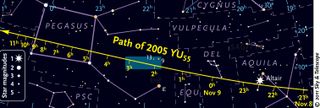
An asteroid the size of a city block zoomed inside the moon's orbit today (Nov. 8) in a rare flyby that marked the closest approach to Earth by such a big space rock in 35 years.
The asteroid 2005 YU55 came within 201,700 miles (324,600 kilometers) of Earth at 6:28 p.m. EST (2328 GMT) Tuesday evening before speeding off into deep space once again at about 29,000 mph (46,700 kph).
The space rock is about 1,300 feet (400 meters) wide. An asteroid this large hasn't come so near to Earth since 1976 and won't again until 2028, researchers said.
The asteroid encounter brought 2005 YU55 closer than the moon, which orbits Earth at an average distance of 238,864 miles (384,499 km). But there was never any danger that 2005 YU55 would slam into Earth today.
Scientists eagerly awaited the close encounter all the same, since it's providing an unprecedented opportunity to learn more about the asteroid and its orbit.
"We would really like to characterize it as much as possible, and learn about its past and about its future," said Marina Brozovic, a scientist with NASA's Near-Earth Object Office at the Jet Propulsion Laboratory (JPL) in Pasadena, Calif., before today's flyby. "I really can't wait to see the images."
Photos and videos of asteroid 2005 YU55 released by NASA just before and during the flyby revealed the space rock to be a relatively round but lumpy object. [See the latest photos and videos of asteroid 2005 YU55]
Get the Space.com Newsletter
Breaking space news, the latest updates on rocket launches, skywatching events and more!
Studying 2005 YU55
Astronomers are taking advantage of the close encounter with 2005 YU55, which was discovered in 2005 by Robert McMillan of the University of Arizona's Lunar and Planetary Laboratory.
Scientists have trained a suite of instruments on the asteroid, including giant radio telescopes at the Arecibo observatory in Puerto Rico and NASA's Deep Space Network facility in Goldstone, Calif.
The aim is to get a better idea of 2005 YU55's size, surface features, rotational period and orbit, researchers said.
2005 YU55 makes one complete lap around the sun every 15 months. Astronomers have already determined that the asteroid poses no threat to Earth for at least the next century, but observations made during this close approach should help them predict its movements even further into the future.
"For many centuries, we'll know exactly where this object is going to be," Brozovic said.
NASA has already released a new image of 2005 YU55 taken by the big Goldstone antenna, with many more surely on the way. And several organizations, including the Clay Center Observatory in Massachusetts and the online telescope service Slooh, provided live webcasts of the space rock's close flyby.

Still visible in telescopes
Skywatchers under clear, dark skies still have a chance to spot 2005 YU55 before it disappears into deep space. The best time to look up is a few hours after closest approach, according to Sky & Telescope magazine.
You'll need a telescope to find the space rock, which is relatively small and dim. Any scope with an aperture greater than 6 inches should be able to spot 2005 YU55, experts say.
The tricky part will be knowing where to look, since 2005 YU55 will be moving across the sky at about 7 degrees per hour (your clenched fist held at arm's length measures about 10 degrees). You can look up the asteroid's coordinates at JPL's Solar System Dynamics website, which is found here: http://ssd.jpl.nasa.gov/.
Note: If you snap a photo of asteroid 2005 YU55 during its Nov. 8 flyby of Earth and would like to share it with SPACE.com for a possible story or photo gallery, send the image and your observing comments to SPACE.com senior writer Mike Wall at mwall@space.com.
You can follow SPACE.com senior writer Mike Wall on Twitter: @michaeldwall. Follow SPACE.com for the latest in space science and exploration news on Twitter @Spacedotcom and on Facebook.
Join our Space Forums to keep talking space on the latest missions, night sky and more! And if you have a news tip, correction or comment, let us know at: community@space.com.

Michael Wall is a Senior Space Writer with Space.com and joined the team in 2010. He primarily covers exoplanets, spaceflight and military space, but has been known to dabble in the space art beat. His book about the search for alien life, "Out There," was published on Nov. 13, 2018. Before becoming a science writer, Michael worked as a herpetologist and wildlife biologist. He has a Ph.D. in evolutionary biology from the University of Sydney, Australia, a bachelor's degree from the University of Arizona, and a graduate certificate in science writing from the University of California, Santa Cruz. To find out what his latest project is, you can follow Michael on Twitter.
Most Popular


